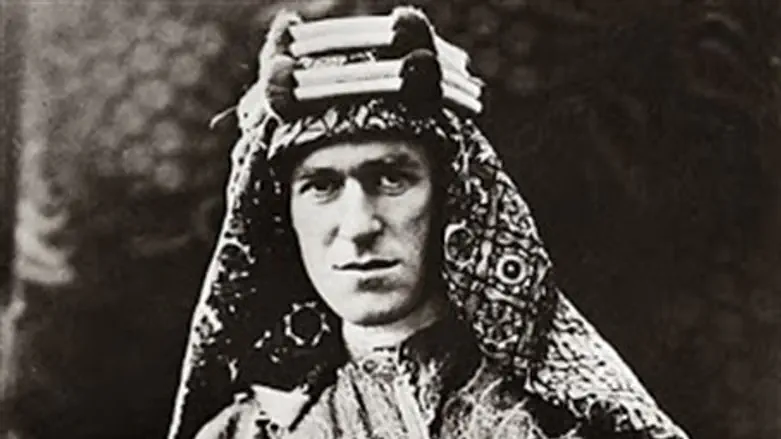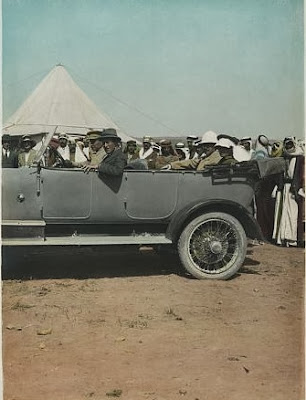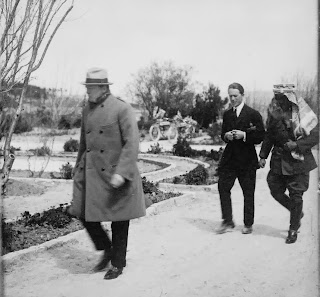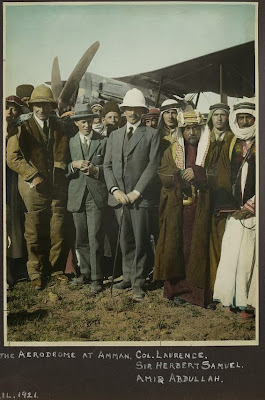
The death of actor Peter O'Toole this week reminded many of his remarkable 1962 film "Lawrence of Arabia", depicting the World War I exploits of a British officer, T. E. Lawrence.
Lawrence is credited with uniting Arab tribes in Arabia against the ruling Ottoman Empire and, through the use of guerrilla tactics, assisting the British war effort to defeat the Turks.
While the film succeeds in portraying the Arab revolt as an important aspect of World War I, it takes some liberties with the facts, starting with the physical differences between O'Toole (6 feet 3 inches - 190 cm) and Lawrence (a diminutive 5 feet 3 inches - 160 cm).
The film also does not present the full extent of Lawrence's diplomatic activities.
Winston Churchill, Lawrence, and Prince Abdullah meeting
in Jerusalem (Library of Congress archives, 1921)
The secret Sykes-Picot Agreement of 1916 divided up the Middle East between colonial powers, France and Great Britain, contrary to promises made by Lawrence to his Arab allies. But after World War I, Lawrence became a publicly acclaimed hero, and he successfully pressed for the granting of territories to his Hashemite allies from the Arabian Hedjaz. Syria (and then Iraq), would be ruled by King Feisal, and Transjordan (77% of the land originally allocated as a Jewish state) would be ruled by Emir Abdullah.
The Weizmann-Feisal meeting brokered by Lawrence
In the course of his work with the Hashemites, T. E. Lawrence introduced Feisal to Zionist leader Chaim Weizmann in December 1918 and served as their interpreter. According to historian Martin Gilbert, Weizmann recorded in his notes: "Feisal explained that 'it was curious there should be friction between Jews and Arabs in Palestine.'" [Weizmann would later become Israel's first president.]
Gilbert continued: "On January 3, 1919, Feisal and Weizmann met again in London, to sign an 'Agreement between the King of the Hedjaz and the Zionists.' Lawrence, who was once again the guiding hand in this agreement, hoped that it would ensure what he, Lawrence, termed 'the lines of Arab and Zionist policy converging in the not distant future.'"
"On March 1, 1919 Lawrence, while in Paris as the senior British representative with the Hedjaz Delegation, drafted and then wrote out in his own hand a letter from Feisal to the American Zionist Felix Frankfurter. In this letter, Feisal declared, 'We Arabs, especially the educated among us, look with the deepest sympathy on the Zionist movement.'”

Lawrence in the front seat, Samuel in
the back at the meeting in Transjordan (1921)
According to the Library of Congress' description of the hand-colored picture below, "The photographs show meetings between Arab, Bedouin, and British officials around April 17-27, 1921, at Amir Abdullah ibn Hussein's camp at Amman, Jordan. During these meetings British High Commissioner Herbert Samuel proclaimed Amir Abdullah as the ruler of Transjordan, under British protection."
The new British High Commissioner to Palestine,
Herbert Samuel, flanked by Lawrence and
Abdullah (hand-colored, 1921)
Lawrence was a key player in the meeting.
One of the photographers at the Amman meeting was John Whiting, a member of the original "American Colony" family and member of the Colony's photographic department. He was also a member of British intelligence and almost certainly had contact with Lawrence.
In 1922, the British split off Transjordan from the Mandate of Palestine. In 1946, the Mandate of Transjordan became the Hashemite Kingdom of Jordan. In the 1948 war with Israel, Jordan occupied the "West Bank" of the Jordan River (until then known as Judea and Samaria), and annexed it in 1950. The annexation was not recognized by the vast majority of the world's countries, including the members of the Arab League.


